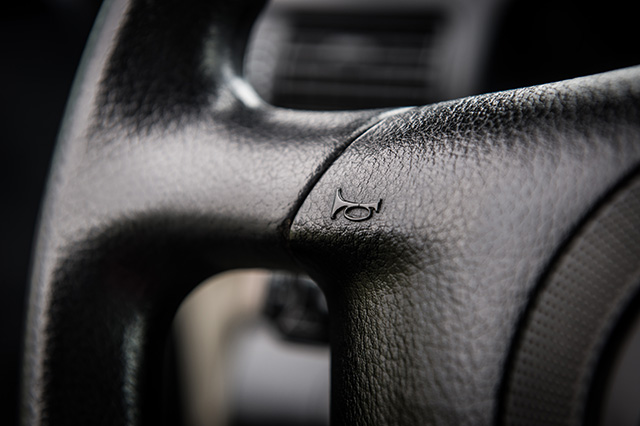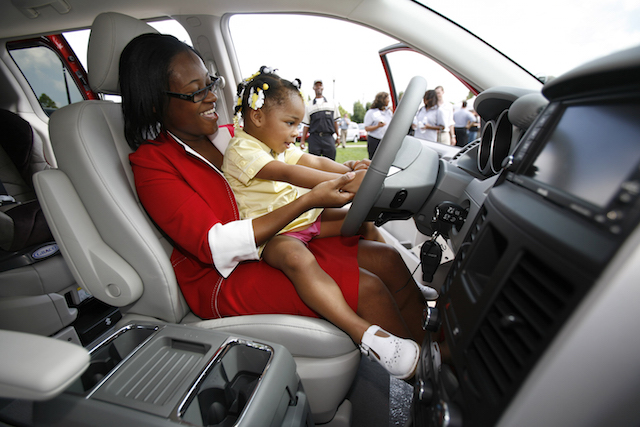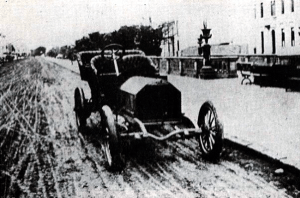If there’s one automotive feature drivers are willing to sound off about it’s the humble car horn. Some people use them, others use them far too liberally. But behind this debate is the fact that car horns are important safety features. They allow drivers to alert pedestrians and other motorists of their presence, hopefully avoiding any injury or damage.
For nearly as long as there have been automobiles, there have been car horns – and the tool’s simplicity means it hasn’t changed too much since. But that doesn’t preclude the history of the car horn from having its share of noteworthy developments.
The History of the Car Horn: Early Car Horns
Car horns were important features on early automobiles. In fact, the biggest change in the car horn since its inception isn’t the feature itself, but in how it’s used. While these days, excessive car honking is considered déclassé, it was polite to use one’s horn in the early 20th century.
“You were expected to honk your horn if you were coming up on pedestrians, to let them know you were bounding down the street,” Matt Anderson, curator for transportation at the Henry Ford museum, told Car and Driver magazine. “You’d be thought rude if you weren’t using your horn, which is the exact opposite of where we are today.”
The first car horns came in three different varieties. Air horns had a plastic bulb the driver could squeeze to emit a sound. Exhaust horns consisted of cuts made into exhaust pipes that elicited a sound similar to a steam engine. Finally, there were electric horns, which are most like what we have today.
The Klaxon Horn
One of the first pioneers of car horn manufacturing was Miller Reese Hutchison. In the early 1900s, the inventor became inspired to create an improved horn after nearly hitting a pedestrian while driving. Hutchison believed car horns should elicit a louder, harsher noise, which is precisely what his invention, the klaxon horn, did. If you’ve never heard of the klaxon horn you’ve almost certainly heard its famous “ahooga” sound.
The klaxon horn became almost immediately ubiquitous on roadways since it was affixed to most Model T’s. It remained the prominent horn of automobiles even as Ford transitioned to the Model A. Eventually, by the 1930s, the klaxon was replaced by electric horns.
Did You Know? Just a few years before the klaxon, Hutchison invented the first portable electrical hearing aids, called Acousticons. This led to none other than Mark Twain joking, “Hutchison invented the Klaxon horn to deafen people so they would have to buy Acousticons.”

How Car Horns Work
Truth be told, the car horn is one automotive feature that hasn’t evolved much over the decades. There have been some changes in look and sound, but the science has remained about the same.
When a driver pushes down on the horn, an electric current travels through a coil to an electromagnet, creating a magnetic field. This field causes a metal diaphragm to flex. Once in this flexed position, contact points disengage and the current flow stops, causing the diaphragm to return back to its flat position and the cycle is repeated. This process continues as long as the horn is being pressed. The vibrations made by the oscillating diaphragm produce the horn sound.
Did You Know? Most of today’s car horns emit a sound of approximately 100-110 decibels.
Modern Car Horns
While the science remains the same, automakers are making slight adjustments to the car horn in order to satisfy the ever-growing and ever-changing automobile market. For instance, GM makes its diaphragms out of tungsten instead of steel because the former lasts longer. This is particularly important in Asia, where drivers tend to honk more often and drive over more rough roads, two factors that can cause horns to wear out.
Some companies are also swapping out copper wires for aluminum, a lighter material that improves a vehicle’s all-important fuel efficiency.
How do you feel about car horns? Do drivers use them too much or maybe not enough? Let us know in the comments below.
Now that you know about the history of the car horn, learn the backstories of other automotive features at AAA.com.
33 Thoughts on “The History of the Car Horn”
Leave A Comment
Comments are subject to moderation and may or may not be published at the editor’s discretion. Only comments that are relevant to the article and add value to the Your AAA community will be considered. Comments may be edited for clarity and length.
















Wish you had explained how the Klaxon horn works
My father had a 1956 Chrysler New Yorker, a tank of a car, and it had the best and loudest car horn I have ever heard. To some extent, It resembled an air horn on a diesel locomotive. When visiting relatives in New Brunswick, Canada one summer, a couple of them wanted to buy the horn because it sounded so great on country roads!
I had a 47 and 48 Chrysler Windsor which had trumpet horns which were tuned too blend with a nice tone,but they sure were loud.Sure wish I had them now.
In the past, automobiles had two horns, each set to play a different frequency, forming part of a dissonant chord. This made the horn sound quite effective. Today, it appears that new cars have only one horn which makes a pathetic “beep” sound. Ah, progress!
I remember in the 50’s that drivers would honk when they were about to pass a car on a two-lane highway, thereby giving the car ahead a “heads-up.” Think of the response one would get today…
I live the Cadillac horn…very distinctive and regal.
Did you know you can have your dealer install a double horn? Very powerful!
Very interesting article, but I’m surprised the author didn’t mention that horse-drawn coaches and carriages used them long before the automobile was invented! So having them on cars was a logical development, like many of the features of early automobiles such as mudguards, running boards, headlamps, et al.
The recent movie UNHINGED shows what can happen when horns are misused.
The main purpose of the car horn is to attract attention, not to tell people hay get out of my way,
The article does not mention the Italian bus horn, with its sing-song tone. It was a unique horn, fun to hear, and totally unique — I have strong memories of that sound from the year I lived in Italy in the 1950s. They were on sale in the US in the 60’s in case you wanted one on your car, but I never heard one on this side of the Atlantic.
While traveling in Bangalore India in 1978, I was amused to see signs on the backs of auto-rickshaws (motor cycled on the front, bench seat in back, canvas cover) signs saying “please honk”. Canvas cover gave no visibility straight back, and driver wanted to know you were back there.
several years ago I had a1968 Plymouth Roadrunner and since Plymouth named the car after a cartoon character the horn sounded like the cartoon character if you push it twice it went ” Beep Beep” most people laughed at it.
I have a 1923 klaxon horn made by Remy. Bought it back in the late ’50s, in Indiana off a truck sitting in a field for $1.00. Back in about ’59, in Copenhagen, Denmark I bought a number of horns, one was beeper & klaxon for also about $1.00 each in a fantastic junk yard. I have photos from this time. Also could have bought a late ’20’s Sunbeam coupe with 6 wire wheels & an overhead 4 cyl for $50.00 (also Copenhagen)
It is an interesting article! Perhaps, with electric cars becoming more common, we will have to go back to “courtesy beeping” as electric cars are largely silent.
I remember that my grandparents has a family honk. They would use a specific series of long and short beeps to alert someone they were outside in the car. (two long followed by two short beeps). I’m assuming this was used more in the city to let someone know it was them outside waiting and not some regular car passing by.
I have been told that car horns have two frequencies, high and low for folk with limited hearing loss.
While waiting for a passenger to cross safely the auto behind me started honking the horn – very annoying drivers out there.
Very enjoyable article, including the interesting connection between Mr. Hutchison (no “n”) and Mark Twain. A brief toot on the car horn can also be a nice way to say “hello” or “goodbye” to a friend.
I toot my horn when an opposing driver flashes me to make a turn ahead of him…it’s a “thanks”
One correction to the story. Air horns would probably have used a rubber bulb not plastic. Early plastics were rigid and would not have held up to squeezing. In New York City in the 1970s (?), for a short time, there was option on cars to have a switch that changed car horn volume from city to highway modes in order to keep down noise pollution. It didn’t last long.
Call horns are necessary safety device.
Unfortunately drivers miss use horns.
To stop the miss use I propose that a 2nd
horn be placed in The passenger compartment. The volume of this whole time should be as loud as the one for the street. This will discourage drivers from using the horn inappropriately. I would like AAA to propose this as a bill to be made into law.
Occasionally drivers show their ignorance and arrogance with the use of their horn. However I wish it would be used more often, BUT for safety reasons.
Horns are not tested everywhere. In New Jersey, beginning four years after a new car is purchased, inspections occur every other year and only test emissions.
When exiting from an underground garage, I always tap the horn once or twice to alert any pedestrians on the sidewalk, since they won’t be visible to me until they’re already in my path.
Are you sure the early air horns were made of plastic, not rubber?
I had the same thought. The article must have been written and edited by “20 somethings”.
LOL
It turns out they did have plastic back then but it was bakelite and wouldn’t be appropriate for horns.
Loved this very information and interesting article. Awesomeness!
Loved your “History of the Horn” article. I found it very interesting and informative. I even read sections to my grandchildren,
With the amount of idiots, distracted drivers and people who don’t know the rules of the road today – the horn has evolved into a important piece of safety for driving.
When did it become popular to supplement the vehicle horn with the middle finger?
Was that invented by Mr Faque II ?
When sitting in stand still traffic the horn is used to much and not enough as a warning.
In Driver Ed, we were taught to sound the horn as we backed up from a blind on both sides parking space. A horn is an alert for others to be aware and not a punishment. Now, noise is considered intrusive and as I watch many ‘near miss’ accidents on the road ahead of me, I wish people would think. A horn is a safety device and that is why it is tested every single year in your car inspection. It is not a decoration.